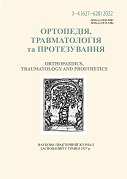Group antibodies as factors specifically influencing erythrocytes sedimentation rate
DOI:
https://doi.org/10.15674/0030-598720223-475-79Keywords:
increase, Erythrocytes, serum, sedimentation, antibodyAbstract
The use of the erythrocyte sedimentation rate (ESR) method has been recognized in monitoring the inflammation process, with a proven role of proinflammatory factors in the ESR increase. The aim. To reveal the role of group antibodies in the specific increase of ESR. Methods. For the study erythrocytes with EDTA anticoagulant were used. ESR was measured after the contact of erythrocytes with saline (negative control), standard anti-A and anti-B antibodies of the IgM class, polyclonal anti-A, anti- B, anti-A, B sera (experiment), as well as serum of group AB in a ratio 1 : 3: 0.2 ml of erythrocytes and 0.6 ml of saline or serum. The results were evaluated after one and 12 hours of incubation, at room temperature and at 4 °C. Results. Contact of anti-A IgM antibodies at a dilution of 1 : 30 with A erythrocytes led to an increase of ESR (from (3.25 ± 0.50) mm/h to (83.7 ± 1.60) mm/h) (p < 0.001) with a presence of a red precipitate. The contact of erythrocytes with polyclonal citrate plasma (or serum) in a ratio of 1 : 2 led to a similar increase in ESR in cases of the specific binding. Anti-A, B serum increased ESR of A erythrocytes up to (53.00 ± 2.64) mm/h (p < 0.001) with the presence of a red precipitate, while anti-B serum did not show such effect: (ESR — (5.25 ± 0.50) mm/h) (p > 0.05). It should be noted that the serum absorbed by the corresponding erythrocytes showed reduced ESR values. After the absorption of anti-A antibodies by A erythrocytes the serum lost the ability to specifically increase the ESR of A erythrocytes. Conclusions. Group antibodies are able to specifically promote ESR. The found ability can be reduced by the method of specific absorption of the serum. The physicians may consider the role of group specific autoimmune antibodies in developing high values of ESR. The therapy aimed to regulate the autoimmune humoral activation and specific absorption might be useful in normalization the ESR parameter.
References
- Plebani, M., & Piva, E. (2002). Erythrocyte Sedimentation Rate. American Journal of Clinical Pathology, 117(4), 621–626. https://doi.org/10.1309/qb1g-6frr-dnwx-bkq9
- Imhof, A., Froehlich, M., Brenner, H., Boeing, H., Pepys, M. B., & Koenig, W. (2001). Effect of alcohol consumption on systemic markers of inflammation. The Lancet, 357(9258), 763–767. https://doi.org/10.1016/s0140-6736(00)04170-2
- Berest, V. P., Borikov, O. Y., Kravchun, P. G., Leontieva, F. S., & Dielievska, V. Y. (2022). Determination of blood group antigens using electrophoresis of erythrocytes incubated with specific antibodies. SEPARATION SCIENCE PLUS, 5 (8), 424‒430. https://doi.org/10.1002/sscp.202200017
- Lai, H.-C., Chou, J.-W., Wu, Y.-H., Huang, P.-J., Cheng, K.-S., & Chen, T.-W. (2022). ABO blood type and clinical characteristics of patients with ulcerative colitis: A hospital-based study in central Taiwan. PLOS ONE, 17(2), e0260018. https://doi.org/10.1371/journal.pone.0260018
- Brigden, M. L. (1999). Clinical utility of the erythrocyte sedimenta-tion rate. American Family Physician, 60 (5), 1443‒1450.
- Abdulrahman, M. A., Jasim, B. A., Al-Samaria, A. M. F. (2020). The rela-tionship between the of prolidase activity and rheumatoid arthritis. EurAsian Journal of BioSciences, 14 (2), 3045‒3049.
- Vallianou, N. G., Evangelopoulos, A. A., Panagiotakos, D. B. [et al.] (2010). Associations of acute-phase reactants with metabolic syndrome in middle-aged overweight or obese people. Medical science monitor : international medical journal of experimental and clinical research, 16 (2), 56–60.
- Roseman, C., Truedsson, L., & Kapetanovic, M. (2012). The effect of smoking and alcohol consumption on markers of systemic inflammation, immunoglobulin levels and immune response following pneumococcal vaccination in patients with arthritis. Arthritis Research & Therapy, 14(4), R170. https://doi.org/10.1186/ar3923
- Grzybowski, A., & Sak, J. (2012). A short history of the discovery of the erythrocyte sedimentation rate. International Journal of Laboratory Hematology, 34(4), 442–444. https://doi.org/10.1111/j.1751-553x.2012.01430.x
- Taye, M. A. (2020). Sedimentation rate of erythrocyte from physics prospective. The European Physical Journal E, 43(3). https://doi.org/10.1140/epje/i2020-11943-2
Downloads
How to Cite
Issue
Section
License

This work is licensed under a Creative Commons Attribution 4.0 International License.
The authors retain the right of authorship of their manuscript and pass the journal the right of the first publication of this article, which automatically become available from the date of publication under the terms of Creative Commons Attribution License, which allows others to freely distribute the published manuscript with mandatory linking to authors of the original research and the first publication of this one in this journal.
Authors have the right to enter into a separate supplemental agreement on the additional non-exclusive distribution of manuscript in the form in which it was published by the journal (i.e. to put work in electronic storage of an institution or publish as a part of the book) while maintaining the reference to the first publication of the manuscript in this journal.
The editorial policy of the journal allows authors and encourages manuscript accommodation online (i.e. in storage of an institution or on the personal websites) as before submission of the manuscript to the editorial office, and during its editorial processing because it contributes to productive scientific discussion and positively affects the efficiency and dynamics of the published manuscript citation (see The Effect of Open Access).














